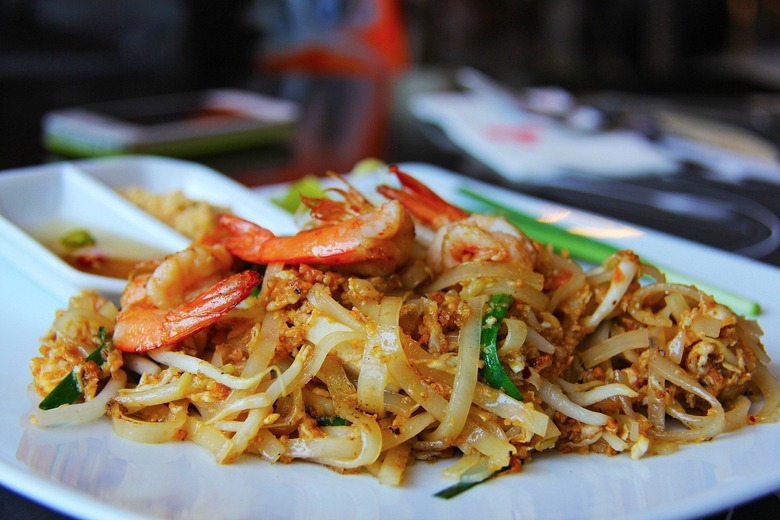Pad Thai Recipe
Pad Thai Recipe
This Pad Thai recipe is how you actually find it in Bangkok and comes from testing hundreds of different variations from food carts all over the city. Pad Thai is the ultimate street food. While "street food" may sound bad, food cart cooks are in such a competitive situation, with such limited space, ingredients and tools they need to specialize in a dish or two just to stay in business. The best of these cooks have cooked the same dish day-after-day, year-after-year, constantly perfecting it.This recipe is courtesy of ThaiTable
servings
3

Ingredients
- 1/2 package thai rice noodles
- 1/2 banana flower (optional)
- 1 1/2 cup chinese chives (optional)
- 2 tablespoon cooking oil
- 2 tablespoon tamarind paste
- 2 tablespoon sugar
- 1 minced shallots
- 1 preserved turnip (optional)
- 1/3 cup extra firm tofu
- 1/2 lime
- 2 tablespoon tablespoons peanuts (optional)
- ground pepper
- 1/2 teaspoon ground dried chili pepper
- 3 cloves minced garlic
- 4 teaspoon fish sauce
- 1 egg
Directions
- Start with soaking the dry noodles in lukewarm or room temperature water while preparing the other ingredients. Getting the noodles just right is the trickiest part of making Pad Thai. Make sure that the noodles are submerged in plenty of water. Check out Tips and Substitutions for in depth explanations. By the time you are ready to put ingredients in the pan, the noodles should be flexible but not mushy. Julienne tofu and cut into 1 inch long matchsticks. When cut, the super firm tofu/pressed tofu should have a mozzarella cheese consistency. You can fry the tofu separately until golden brown and hard, or you can fry with other ingredients below.
- Cut the Chinese chives into 1 inch long pieces. Set aside a few fresh chives for a garnish. Rinse the bean sprouts and save half for serving fresh. Mince shallot and garlic together.
- Use a wok. If you do not have a wok, any big pot will do. Heat it up on high heat and pour oil in the wok. Fry the peanuts until toasted and remove them from the wok. The peanuts can be toasted in the pan without oil as well. Add shallot, preserved turnip, garlic and tofu and stir them until they start to brown. The noodles should be flexible but not expanded at this point.
- Drain the noodles and add to the wok. Stir quickly to keep things from sticking. Add tamarind, sugar, fish sauce and chili pepper. Stir. The heat should remain high. If your wok is not hot enough, you will see a lot of juice in the wok at this point. Turn up the heat, if it is the case.
- Make room for the egg by pushing all noodles to the side of the wok. Crack the egg onto the wok and scramble it until it is almost all cooked. Fold the egg into the noodles. The noodles should soft and chewy. Pull a strand out and taste. If the noodles are too hard (not cooked), add a little bit of water. When you get the right taste, add shrimp and stir. Sprinkle white pepper around. Add bean sprouts and chives. Stir a few more times. The noodles should be soft, dry and very tangled.
- Pour onto the serving plate and sprinkle with ground pepper and peanuts. Serve hot with the banana flower slice, a wedge of lime on the side, raw Chinese chives and raw bean sprouts on top.
- As always, in Thailand, condiments such as sugar, chili pepper, vinegar and fish sauce are available at your table for your personal taste. Some people add more chili pepper or sugar at the table.